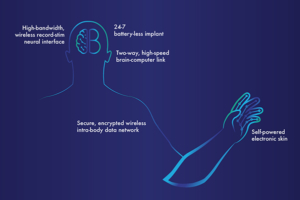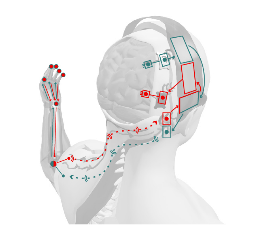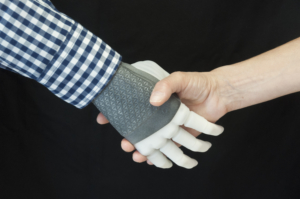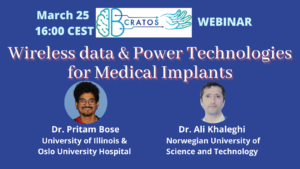1st B-CRATOS Newsletter
March 2022
Dr Robin Augustine, B-CRATOS coordinator, Interview
In this short interview, we speak with Dr Robin Augustine, B-CRATOS project Coordinator, about the first year of the project, and address the following questions:
- What inspired Dr Augustine and the partners to propose this ambitious B-CRATOS project?
- What has been challenging during this first year of the B-CRATOS project?
- How does he see the critical next steps for the B-CRATOS project in 2022-23?
Watch the Interview !
B-CRATOS Project Goals
Innovation Goals
The EC Horizon 2020 FET Open funded project B-CRATOS “Wireless Brain-Connect inteRfAce TO machineS” aims to create a symbiosis of visionary technologies for a breakthrough brain-machine interface.
The modern day BCI is dependent on tethered solutions to transfer brain data and bulky back-end processing infrastructures which poses major handicaps in realizing real-time wearable/implantable systems.
B-CRATOS scientific innovations include: fully-implantable and battery-free neural interface circuitry with Utah electrode array, leveraging wireless power and data transfer technologies; long-distance, tether-less, high bandwidth, low latency Fat-Intrabody communication technology; a low-power, advanced AI-based compute module for processing and decoding motor and somatosensory signals; a beyond state-of-the-art highly dextrous bionic hand; and a unique bio-inspired artificial (electronic) skin.
A primary technological goal for B-CRATOS is to further develop, integrate, and demonstrate these technologies in a new BCI platform through benchside and in vivo tests.
Future Impact
In the realm of healthcare applications, B-CRATOS aims to develop this new BCI platform to serve as an “always-on” (i.e. continuous 24/7 operation without medical supervision) wireless implant for recording and stimulation/neuromodulation of neurons anywhere in the central or peripheral nervous system, to enable learning and brain plasticity necessary for complete integration of biophysical sensors and prosthetics. The secure, encrypted intra-body data network offered by B-CRATOS could enable and advance many future medical applications, such as brain-organ communication, intra-body sensor network, wearable exoskeletons, and improved bionic arm control.
Beyond healthcare, the two-way high-speed brain-computer link being developed in B-CRATOS may also facilitate real-time sensing and stimulation for augmented reality, learning and even gaming applications. The self-powered mechano-electric transduction-based tactile sensing utilized in B-CRATOS enables large-area, self-powered electronic skin with high spatial resolution, which could be used anywhere from treating burn injuries to augmented reality. The B-CRATOS consortium expects that these technologies will have profound positive impact in the Neural Disease treatment, Electroceutical, AI, Exoskeleton and Robotics sectors.
Discover How B-CRATOS will work
B-CRATOS is Building a New Kind of *Wireless* Brain Computer Interface: WHY?
A Wireless B-CRATOS BCI System
The B-CRATOS project aims to build a new wireless BCI system that both translates high-bandwidth brain activity into control signals to control a prosthetic limb and simultaneously converts tactile information detected by electronic skin into electrical cortical stimulation to restore the sense of touch. In other words, the consortium is designing a more natural and capable prosthetic system. At the core of this effort is the design and integration of novel wireless power transfer and data transmission technologies developed by specialists at NTNU and Uppsala University, as we have previously highlighted.
But upon hearing this, one might respond, “But aren’t there already medical devices using either implanted wires, batteries, or existing wireless technologies? What is novel here?”
Indeed, there are many implantable systems that use wires and batteries (and some have already gone wireless!). This includes pacemakers, deep brain stimulators (DBS) and other implantable pulse generators, glucose monitors and other sensors, and cochlear implants, to name a few. These systems can deliver electrical stimulation to in-body targets, such as the heart or brain, or monitor physiologic signals, such as brain activity or blood glucose levels. The most common cortical neural implants, the pacemaker-inspired DBS devices, have long used subcutaneous wires to link chest-implanted battery-containing pulse generators to implanted electrodes. It might appear that current capabilities overlap with the envisioned B-CRATOS record and stimulation neural interface, and a modern BCI could already be within grasp.
So, why do we need B-CRATOS to innovate wireless technologies?
While existing implantable systems have successfully connected indwelling devices to external hardware through the skin in many cases (drug pumps, early BCI systems), the argument for retiring dependence on transcutaneous connectors is straightforward. Any compromise of skin barrier integrity potentially increases the risk of infection, future surgical revision, and requires increased care and monitoring, which poses a major challenge for everyday use. And infection is a major concern: a meta-analysis of hardware complications in any DBS system found infection accounted for the greatest risk of reported adverse events, even including fully implantable systems. And although wires fully implanted within the body may not compromise the skin surface by design, the presence of additional “foreign body” hardware increases risks and surgical complexity, and thus the probability of infection. Furthermore, other wire-related complications such as scar tissue adhesions (sometimes referred to as “tethering” or “bow-stringing”) and wire breakage also necessitate surgical revision and repairs, again, increasing patient risk. By transmitting data through tissue, not wires, B-CRATOS seeks to pioneer a novel solution for these challenges.
There exists a growing category of implantable systems leveraging wireless technologies, such as the Responsive Neural Stimulator System (RNS) by NeuroPace and cochlear implants by Med-El, Cochlear, Advanced Bionics, and others. The battery-powered RNS uses a wireless link to enable device programming and even occasional data downloads: the RNS-320 stores about one hour of intracranial EEG data on a small number of channels. Modern cochlear implant systems wirelessly transmit stimulation commands from an external wearable to an implantable stimulator and have discarded bulky batteries in favor of wireless power transfer.
But for a BCI system with the aim of decoding brain activity into complex control like B-CRATOS, these existing wireless technologies are insufficient. For example, the best long-term BCI decoding systems typically utilize large numbers (hundreds) of neural data channels collected at high sample rates (tens of kilosamples per second) and high bandwidth, for (near) real-time processing and decoding. This is in stark contrast to the low channel counts and sample rates of the RNS and other devices: existing wireless implantables do not have these ambitious requirements for data and power. And the Big Data approach in BCI decode algorithms is reflected in the accelerated drive towards new technologies seeking to boost recording channel count and data rates, by such efforts as Neuropixels at UCL, Blackrock Neurotech, NeuroNexus, Neuralink, among others.
Conclusion
Transferring data at the needed scale and speeds for a modern BCI prosthetic will require breakthrough wireless solutions for safe, effective, everyday use. And alongside wireless data transfer, there will be a need for innovations in power reduction, size optimization, and long-term biocompatibility. In the coming years, B-CRATOS will build and demonstrate a system testing the boundaries of what is possible with wireless technologies and deliver an untethered bidirectional BCI platform to enable more advanced decoding and complex closed-loop applications, beyond the current state-of-the-art.
Paul Wanda, PhD, Blackrock Microsystems Europe GmbH
Three reasons for a touching neuroprosthesis
B-CRATOS 2nd Webinar – February 25, 2022
February 25, 2022 B-CRATOS 2nd Webinar on “Wireless data and Power Technologies for Medical Implants”
Information & Registration
Project details:
TITLE: Wireless Brain-Connect inteRfAce TO machineS
START-END: March 2021 – February 2025
EU CONTRIBUTION: €4,475,059.25
TOPIC: FETOPEN-01-2018-2019-2020: FET-Open Challenging Current Thinking
This project has received funding from the European Union’s Horizon 2020 research and innovation programme under grant agreement N° 965044








